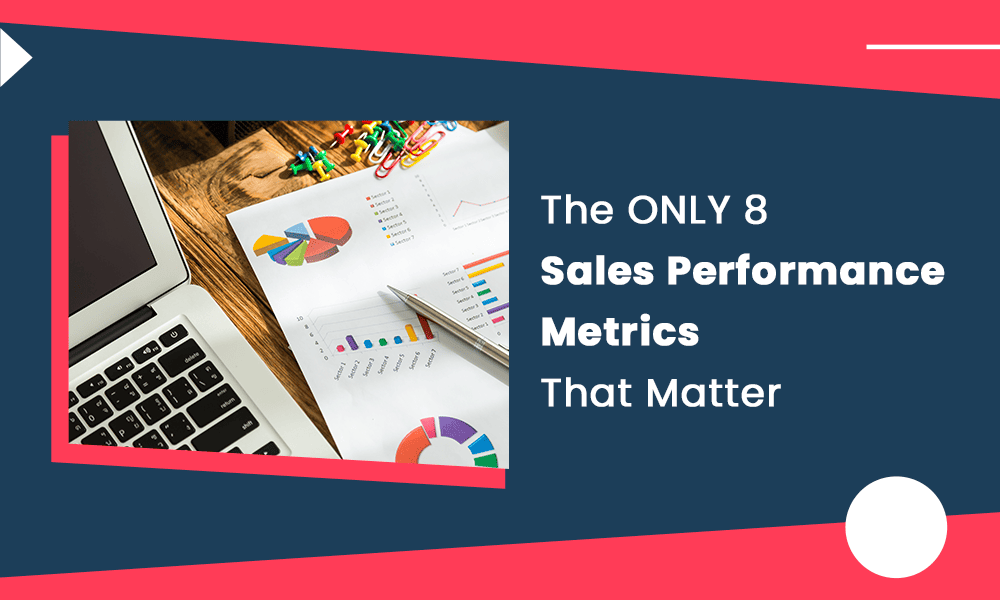Without sales performance metrics, you’re really just guessing at whether your sales team is excelling or coming up short.
In any area of business, guessing simply isn’t good enough. You need a means of gauging sales performance, and metrics are the only way to do it consistently over time.
In this blog post, we’ll share the only eight (8) sales performance metrics you’ll ever need to track!
Table of Contents
What Are Sales Performance Metrics?
Sales performance metrics are also referred to as key performance indicators or KPIs. These metrics are a collection of data that determines how well your sales team is performing.
You can review total sales, open versus closed deals, new versus acquired customers, and so many more metrics. If you wish to track only the performance of certain reps on your sales team, that’s a possibility.
You can also study the performance of whole sectors of your sales team or even the entirety of the team if you wish.
Read also: 16 Key Sales KPIs for Small Businesses: Boost Your Revenue
Tracking Sales Performance Metrics: 8 Metrics that Matter Most
Sales performance metrics are only as valuable as the ones you track. You can’t only follow the metrics that are about the dollars but also about lead and customer behavior as well.
Let’s look at the key sales metrics in detail now.
1. Follow-Up Time and Cost
How much time are your sales reps spending on following up with leads? How much money is this costing them?
We’re not saying that following up with leads is ever a fruitless endeavor, but it can be. Your reps need to know when enough is enough.
Perhaps, if you haven’t already, you want to institute a rule on following up.
For instance, if the lead doesn’t respond after three spaced-out attempts, then it’s time to move on. Otherwise, your sales reps are sinking too much time, and time is money!
Read also: Sales Blitz Definition, Example, and Strategy
2. Lead Response Time
Lead Response Time indicates the average amount of time a sales rep needs to follow up with a contact who has become a lead.
The lead has become responsive to your company’s efforts, but their interest won’t last forever. The Lead Response Time rate thus should be low.

3. Customer Retention
It’s every company’s goal to never lose a customer, but sometimes, that simply isn’t possible.
Your small business must begin tracking your customer retention rate from today onward.
If it’s lower than average, it’s not only the fault of your sales team. It could be that your marketing or customer service efforts need improving, for example.
Read also: Top 10 Sales Analysis Software for Small Business Owners
4. Deals Lost
This is a metric that your small business will want to keep as low as possible, as deals lost indicates that your company’s sales performance is suffering.
Perhaps your sales reps are going after the wrong type of lead, they’re wasting too much time with following up, or they’re blowing the deal somewhere along the way.
You need to go back and review individual versus collective deals lost to get a better understanding of what might be going wrong so you can begin to fix it.

5. Conversion Rate by Sales Funnel Stage
Conversion rates are excellent for your small business, as that means you’re producing more customers out of your leads.
At which sales funnel stage are these conversions happening the most often? Is it earlier on (which would be impressive) or later in the sales funnel?
If you notice consistent trends in how customers track through your sales funnel, you can share this information with your sales reps so they have a better understanding of what the average customer journey looks like.
Read also: The Sales CHAMP Framework and How It Can Help Your Business
6. Win Rate
The win rate is an important sales performance metric, but as you’ve seen, not the most important.
Once again, we recommend you look at both the individual sales rep win rates and the win rates for your overall sales team.
You will have a few standout sellers for sure, but if everyone’s win rates are about equal otherwise, then your sales team has no weak links.

7. Customer Lifetime Value
Customer Lifetime Value or CLV is a measure of how much money your small business can make out of each of your customers on average.
To calculate the CLV, you first need to know the customer’s Lifetime Value.
You’d multiply their average value of sales by the number of completed transactions by the retention period to get the Lifetime Value.
Then you take the Lifetime Value and multiply that by your small business profit margin and you have the CLV.
Read also: OKR Examples That Bring Out The Best In Different Teams
8. Customer Acquisition Cost
While the goal of running a business of any size is acquiring customers, your company must be cognizant of how much it’s costing you to do that.
The Customer Acquisition Cost or CAC will tell you.
Calculating the CAC is easy. Take your cost of sales plus the cost of marketing and divide that total by the number of new customers your small business has acquired.
The CAC should be commensurate with what your company is spending on marketing. If it isn’t, then you need to revise your marketing and advertising budgets.
Read also: 16 Sales Dashboards That Make Sales Fun
Why Sales Performance Metrics Matter
If you have yet to track sales performance metrics, it’s worth starting today, right this very minute.
You can never go back and regain the lost time and the lost metrics that go along with it, but you can begin building a historic record of data from this point forward.
When you do, you can begin reaping the following benefits.

They Tell You If You’re Achieving Sales Goals
Going back to our point from the intro, it can become impossible to determine without sales performance metrics whether your sales reps are meeting quotas or not.
You can’t even look at your company revenue, as you can’t confidently ascribe all the credit to the sales reps when some of those earnings might have come from your marketing department or other departments within your company.
You need sales metrics to inform and guide you.
Read also: The 10 Best Sales Books (That Aren’t About Manipulation and Bull****)
Help You Plan Future Goals
How can sales metrics guide you? That’s simple.
You can review your current sales goals and compare how your sales reps are performing to determine if you perhaps overshot your goals or even undershot them.
It’s easy enough to write off one month or one sales quarter as a fluke, but if longer-term data suggests that your approach isn’t working or that your sales goals are too ambitious, then it’s time to change tact.
The longer you continue with something that isn’t working, the more you’re impeding the company’s bottom line!
Read also: 10 Sales Productivity Tools That You’d Want To Buy Today
Make It Easier to Identify Superstar Sales Reps
You’ll recall from the last section that you can use sales performance tools and software to separate metrics by entire sales teams or even individual sales reps.
It’s good to review the performance of each rep of the team to see who’s the brightest seller on the squad and who could use some help.
Once you identify your superstar sales reps, so to speak, you can use them as an example of what the other sales reps should be attaining to.
You can also pick the brain of this sales rep and possibly use their guidance and assistance to improve the performance of your other sales reps.
For instance, perhaps there’s a script your superstar sales rep uses or a certain strategy they like to employ that the others on the team aren’t doing enough.
On the opposite side of the spectrum, when you realize that sales team members are underperforming, it’s a good idea to monitor them to look for any trends.
If the trend of underperformance continues, you might wish to pull this sales rep aside and possibly enroll them in additional training to make them more effective at their jobs.
Read also: 11 Sales Tools To Supercharge Your Sales Stack
Wrap Up
Sales performance metrics are a necessary part of understanding how your sales team performs, including the good, the bad, and the ugly.
Now that you know which metrics to begin measuring, you can reassess and redefine your company’s definition of success!
If you want to try one of the most affordable all-in-one sales automation software, try EngageBay.
